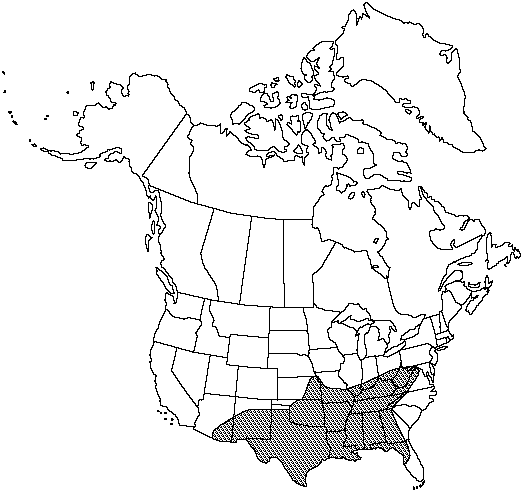Difference between revisions of "Ophioglossum engelmannii"
Ber. Deutsch. Bot. Ges. 1: 351. 1883.
FNA>Volume Importer |
FNA>Volume Importer |
||
| Line 17: | Line 17: | ||
}}<!-- | }}<!-- | ||
| − | --><span class="statement" id="st- | + | --><span class="statement" id="st-undefined" data-properties=""><b>Roots </b>to 25 per plant, tan to brown, 0.5-1.5mm diam., straight, producing proliferations. <b>Stem</b> upright, to 1.5 cm, 4 mm diam., leaves 1-2 per stem. <b>Trophophore</b> stalk to 0.1 cm, 0.01 times length of blade. <b>Trophophore</b> blade erect to spreading, commonly ± folded when alive, uniformly pale green throughout when dried, dull, ovate to ovate-lanceolate, 10 × 4.5 cm, firm, herbaceous, base narrowed abruptly, apex with apiculum to 0.8 mm; venation complex-reticulate, veinlets forming numerous, very tiny, secondary areoles within the major areoles. <b>Sporophores</b> arising at ground level, 1.3-2.5 times as long as trophophore; sporangial clusters 2-4 × 0.13-0.31 cm, pairs of sporangia 20-40, apiculum 0-1.3 mm.</span><!-- |
-->{{Treatment/Body | -->{{Treatment/Body | ||
| + | |phenology=Leaves appearing early–late spring, often with second flush later in season following summer rains. | ||
|habitat=Mostly in soil over limestone in open fields, pastures, and cedar glades | |habitat=Mostly in soil over limestone in open fields, pastures, and cedar glades | ||
|elevation=50-1000 m | |elevation=50-1000 m | ||
| Line 38: | Line 39: | ||
|basionyms= | |basionyms= | ||
|family=Ophioglossaceae | |family=Ophioglossaceae | ||
| + | |phenology=Leaves appearing early–late spring, often with second flush later in season following summer rains. | ||
|habitat=Mostly in soil over limestone in open fields, pastures, and cedar glades | |habitat=Mostly in soil over limestone in open fields, pastures, and cedar glades | ||
|elevation=50-1000 m | |elevation=50-1000 m | ||
| Line 45: | Line 47: | ||
|publication year=1883 | |publication year=1883 | ||
|special status= | |special status= | ||
| − | |source xml=https://jpend@bitbucket.org/aafc-mbb/fna- | + | |source xml=https://jpend@bitbucket.org/aafc-mbb/fna-data-curation.git/src/9216fc802291cd3df363fd52122300479582ede7/coarse_grained_fna_xml/V2/V2_178.xml |
|genus=Ophioglossum | |genus=Ophioglossum | ||
|species=Ophioglossum engelmannii | |species=Ophioglossum engelmannii | ||
| − | |||
| − | |||
| − | |||
| − | |||
| − | |||
| − | |||
| − | |||
| − | |||
| − | |||
| − | |||
| − | |||
| − | |||
| − | |||
| − | |||
| − | |||
| − | |||
| − | |||
| − | |||
| − | |||
| − | |||
| − | |||
| − | |||
| − | |||
| − | |||
| − | |||
| − | |||
| − | |||
| − | |||
| − | |||
| − | |||
}}<!-- | }}<!-- | ||
-->[[Category:Treatment]][[Category:Ophioglossum]] | -->[[Category:Treatment]][[Category:Ophioglossum]] | ||
Revision as of 14:13, 27 July 2019
Roots to 25 per plant, tan to brown, 0.5-1.5mm diam., straight, producing proliferations. Stem upright, to 1.5 cm, 4 mm diam., leaves 1-2 per stem. Trophophore stalk to 0.1 cm, 0.01 times length of blade. Trophophore blade erect to spreading, commonly ± folded when alive, uniformly pale green throughout when dried, dull, ovate to ovate-lanceolate, 10 × 4.5 cm, firm, herbaceous, base narrowed abruptly, apex with apiculum to 0.8 mm; venation complex-reticulate, veinlets forming numerous, very tiny, secondary areoles within the major areoles. Sporophores arising at ground level, 1.3-2.5 times as long as trophophore; sporangial clusters 2-4 × 0.13-0.31 cm, pairs of sporangia 20-40, apiculum 0-1.3 mm.
Phenology: Leaves appearing early–late spring, often with second flush later in season following summer rains.
Habitat: Mostly in soil over limestone in open fields, pastures, and cedar glades
Elevation: 50-1000 m
Distribution

Ala., Ariz., Ark., Fla., Ga., Ill., Ind., Kans., Ky., La., Miss., Mo., Ohio, Okla., N.Mex., N.C., Tenn., Tex., Va., W.Va., Mexico, Central America.
Discussion
Selected References
None.
